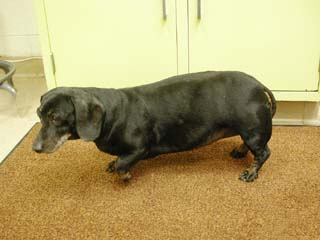
| This is a picture of a dog with Cushing’s disease. Notice the “pot-bellied” appearance and thinning of the hair around the head and ears. |
Introduction:
Cushing’s disease is a slowly progressive condition that is a result of abnormally high levels of cortisol in the body. Cortisol is a steroid hormone produced by the body’s paired adrenal glands, specifically by the gland’s cortex or outer layer. Hence, the name hyper-(too much) adreno-(adrenal) corticism (cortex). The adrenal glands in dogs with hyperadrenocorticism have, in effect, a broken "off switch" and produce too much cortisol. Excess cortisol results in many different problems throughout the body.Causes: This disease is most commonly caused by a tumor of the pituitary gland. The pituitary gland normally stimulates the adrenal gland to produce cortisol. When the pituitary gland has a tumor, it over-stimulates the adrenal gland and excessive amounts of cortisol are produced. Less commonly, the problem is actually a tumor in the adrenal gland itself. This tumor also results in excess production of cortisol by the adrenal gland.
Clinical Signs: The typical dog with Cushing’s disease experiences an increase in appetite and a slow, but progressive loss of muscle tone in the abdomen and limbs. These dogs often have a "pot-bellied" appearance.
The skin and hair may be involved, particularly over the neck, flank, and ears. In these areas, the skin and hair are thin and the surface of the skin is often inflamed. Most animals experience increased thirst and the need to urinate.
 |
|
Diagnosis: Physical examination may immediately lead to suspicion of hyperadrenocorticism. In dogs with Cushing’s disease, there are also some common changes in a blood chemistry profile and in a complete blood cell count (CBC). These changes may include decreased lymphocytes and eosinophils, with increases in neutrophils, glucose, and alkaline phosphatase. Please refer to Section D for additional information on the above tests.
There are many other tests that can be performed looking specifically for Cushing’s disease. The most frequently performed test is called the ACTH stimulation test. This is a crude measurement of the size of the dog’s adrenal glands and how much cortisol the glands can produce.
Treatment: Depending on the type and the location of the problem, some dogs may only require medications, while others may require surgery. If the disease can be managed medically, oral mitotane is commonly used. This drug causes death of the over-productive cells of the adrenal gland, thereby trimming down the size of the gland and limiting its ability to produce cortisol. Dogs with an adrenal tumor may require surgery to remove the adrenal gland. Management of dogs with Cushing’s disease is invariably challenging and may be quite expensive. Complications are common and the average life span of a dog diagnosed with Cushing’s disease is approximately 2 years with treatment.